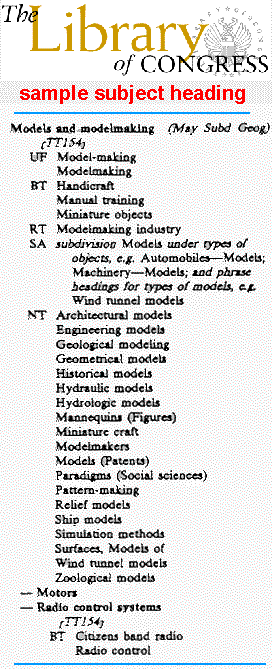The Digital Research Initiative
The University of North Carolina at Chapel Hill
The Library of Congress subject headings system was originally designed as a
controlled vocabulary for representing the subject and form of the books and
serials in the Library of Congress collection, with the purpose of providing
subject access points to the bibliographic records contained in the Library of
Congress catalogs.
As an increasing number of other libraries have adopted the Library of Congress
subject headings system, it has become a tool for subject indexing of library
catalogs in general. In recent years, it has also been used as a tool in a number of online
bibliographic databases outside of the Library of Congress.
A subject heading may consist of one or more words. A one-word heading represents
a single concept, whereas a multiple-word heading may represent a single concept
or multiple concepts.
A subject heading representing a single concept may appear as a single word or a
multiple-word phrase, usually an adjectival phrase but occasionally a
prepositional phrase. Each such heading represents a single object or idea (Examples include: Automobiles, Botany, Budget deficits, Electric interference, Boards of trade, Clerks of court).
 |
The Library of Congress (LC) subject headings are used to find
information by keywords in libraries in the United States. The red,
four-volume Library of Congress Subject Headings (LCSH) set is
an important guide to finding the keyords to use in the SUBJECT search option in
the UNC-CH Online Catalog, or the UNC-CH Online Catalog
Services.
By looking in the LCSH you can often avoid frustration, save time, and
locate useful terms that might not have occurred to you. 
On
the left is a sample from the LCSH.
See below for an
explanation of its use.
Note:
- Headings in boldface may be used for subject
searching. For example, "Models and modelmaking" may be used
as a subject heading.
- May Subd Geog.
Place names may follow the heading.
- Call number
given (TT154) indicates where most books on this subject are found.
Rather than search further, you might just go directly to this call number.
-
UF (Used For) refers to headings which are not
used.
- BT (Broader Topic) refers to more
general subject headings. These headings would be useful if you need to broaden
your topic.
- RT (Related Topic). These
terms can provide ideas of other topics to investigate.
-
SA (See Also) refers you to other ways of looking up the same
topic.
- NT (Narrower Topic) refers to more
specific headings than the boldface heading.
- --
(a dash) refers to a subdivision of the boldface subject heading.
These listed subdivisions are useful for narrowing a topic.
|
Types of Relationships within Subject Headings
Pre-coordinated Relationships
A pre-coordinated multiple-concept heading contains two or more otherwise
individual or independent concepts coordinated or related through one or more
linking devices. Pre-coordination results in phrase headings or
main-heading/subdivision combinations. Examples include: Budget in business, Church and industry, Earth-Rotation, Biology-Scholarships, fellowships, etc.
Term relationships
Three types of relationships are represented in the cross- reference structure of
Library of Congress Subject Headings: equivalence, hierarchical, and associative.
These relationships are expressed in terms of USE, UF (Used for), BT (Broader
term), NT (Narrower term), RT (Related term), and SA (See also) references. Each
reference links a term or heading with another heading or with a group of
headings..
Equivalence relationships
USE references are made from unauthorized or non-preferred terms to authorized or
valid headings. Reciprocals, in the form of UF (Used-for) references, are made
under the valid headings. The referred-from terms include synonyms in direct and
inverted word order, alternative spellings (including singular and plural forms),
alternative endings, changed or canceled headings, and abbreviations and
acronyms. For phrase headings entered in the inverted form, USE references are
made from the straight form. For phrase headings entered in the straight form,
USE references are made from the inverted form in selective cases. For compound
headings and for topical headings subdivided by other topics, USE references are
made from the reversed form, thus bringing each significant term to the initial
position. Occasionally, USE references are made to broader headings from narrower
terms not used as valid headings. USE references are not generally made from
equivalents in foreign languages. Examples
Hierarchical relationships
Headings related hierarchically are connected by means of reciprocal BT (Broader
term) and NT (Narrower term) references. A heading is linked to the level
immediately above it and the level immediately below it in the appropriate
hierarchy. Types of hierarchical relationships include Genus/species (or
class/class member), Whole/part, and Instance (or generic topic/proper name
example).
Broader terms
Under each valid heading, other headings representing concepts on a level
immediately above in the hierarchy are listed as BT (Broader term), except when
the heading in question represents the "top term" in the hierarchy, or when the
broader term cannot be readily identified. Other exceptions include headings for
geographic regions, family names, and inverted headings qualified by names of
languages, nationalities, ethnic groups, or terms that designate time periods,
when the only appropriate BT is the identical heading without the qualifier. When
a heading belongs to more than one hierarchy, multiple BT references may be made.
In complex situations such as compound headings, prepositional phrase headings,
and headings with subdivisions, BT references not representing true hierarchical
relationships are made in selective cases.
Associative relationships
Headings related in some manner other than by hierarchy are linked with RT
(Related term) references. Such references may be made for the following types of
relationships: headings with meanings that overlap to some extent, headings
representing a discipline and the object studied, and headings representing
persons and their fields of endeavor. Examples: Ships RT Boats and boating Birds
RT Ornithology Medicine RT Physicians
This site made by

|

|
This site was created especially for students of the UNC School of Journalism's
JOMC 050 Class, and anyone else who may be interested.
For more information, please contactdaikat@email.unc.edu
|



